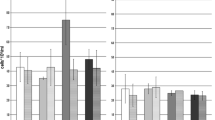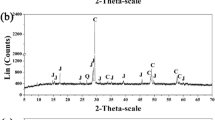Abstract
The effects of introducing M. sedula derivatives having different Cu2+-resistance on bioleaching capacity of a defined consortium (consisting of A. brierleyi DSM1651 and M. hakonensis HO1-1) were studied in column reactors at 70 °C. Introducing M. sedula copA mutant, a copper sensitive derivative, only had negligible effects on bioleaching. While introducing M. sedula ARS50-2, a Cu2+ resistant strain, substantially consolidated bioleaching process, with 27.77% more copper recovered after 58 d of bioleaching. Addition of M. sedula ARS50-2 likely enhanced the sulfur oxidation capacity of consortium after the 24th day under the Cu2+ stress. The majority of extreme thermoacidophiles were attached on minerals surface as indicated by quantitative PCR (qPCR) data. Successions of microbial community of extremely thermoacidophilic consortia that attached on surface of minerals were different from those in leachate. M. hakonensis HO1-1 was the dominant species attached on minerals surface in each column reactor throughout bioleaching process. The sessile M. sedula ARS50-2 remained as a major species till the 34th day. A. brierleyi DSM1651 was the most abundant planktonic species in leachate of each column reactor. These results highlight that higher Cu2+-resistance is a beneficial trait for extreme thermoacidophiles to process copper minerals.
摘要
本文研究了分别引入具有不同 Cu2+抗性的 M. sedula 菌株对极端嗜热菌群(由 A. brierleyi DSM1651 和 M. hakonensis HO1-1 组成)在 70 °C 柱浸反应器中浸出硫化铜矿的影响. 引入 Cu2+敏感的 M. sedula copA 突变菌株对硫化铜矿的浸出几乎没有影响, 铜浸出率没有提高. 然而, 引入 Cu2+ 抗性 M. sedula ARS50-2 能显著地强化浸出过程, 铜浸出率在第 58 天提高了 27.77%. 第24 天后浸出液的 pH 表明M. sedula ARS50-2 的加入能提高极端嗜热菌群的硫氧化活性. 定量 PCR 数据表明在浸出过程中, 各反应器中矿物表面与浸出液中的极端嗜热菌群群落结构不同. 极端嗜热菌在浸出过程中主要吸附在矿物表面. M. hakonensis HO 1-1 是浸出过程中各个反应器矿物表面的主要菌株. M. sedula ARS50-2 在浸出的第 34 天仍然是矿物表面的主要的菌株. A. brierleyi DSM1651 是浸出过程中各柱浸反应器浸出液中的主要菌株. 相关数据表明加入高 Cu2+抗性菌株有利于极端嗜热菌在高浓度 Cu2+胁迫 条件下对硫化铜矿的浸出.
Similar content being viewed by others
References
NORTHEY S, MOHR S, MUDD G M, WENG Z, GIURCO D. Modelling future copper ore grade decline based on a detailed assessment of copper resources and mining [J]. Resources, Conservation and Recycling, 2014, 83: 190–201. DOI: 10.1016/j.resconrec.2013.10.005.
WATLING H R. Review of biohydrometallurgical metals extraction from polymetallic mineral resources [J]. Minerals, 2015, 5: 1–60. DOI:10.3390/min5010001.
ZHAO Hong-bo, ZHANG Yi-sheng, ZHANG Xian, QIAN Lu, SUN Meng-lin, YANG Yu, ZHANG Yan-sheng, WANG Jun, KIM H, QIU Guan-zhou. The dissolution and passivation mechanism of chalcopyrite in bioleaching: An overview. [J]. Minerals Engineering, 2019, 136: 140–154. DOI: 10.1016/j.mineng.2019.03.014.
LIANG Yu-ting, HAN Jun-wei, AI Chen-bing, QIN Wen-qing. Adsorption and leaching behaviors of chalcopyrite by two extreme thermophilic archaea [J]. Transactions of Nonferrous Metals Society of China, 2018, 28(12): 2538–2544. DOI: 10.1016/S1003-6326(18)64900-3.
PETERSEN J, DIXON D G. Thermophilic heap leaching of a chalcopyrite concentrate [J]. Minerals Engineering, 2002, 15: 777–785. DOI: 10.1016/S0892-6875(02)00092-4.
PRADHAN N, NATHSARMA K C, SRINIVASA RAO K, SUKLA L B, MISHRA B K. Heap bioleaching of chalcopyrite: A review [J]. Minerals Engineering, 2008, 21(5): 355–365. DOI: 10.1016/j.mineng.2007.10.018.
VALD S J C, RDENAS J P, QUATRINI R, ESPARZA M, OSORIO H, DUARTE F, LEFIMIL C, SEPULVEDA R, JEDLICKI E, HOLMES D S. Comparative genomics begins to unravel the ecophysiology of bioleaching [J]. Hydrometallurgy, 2010, 104(3, 4): 471–476. DOI: 10.1016/j.hydromet.2010.03.028.
ACOSTA M, GALLEGUILLOS P, GHORBANI Y, TAPIA P, CONTADOR Y, VELSQUEZ A, ESPOZ C, PINILLA C, DEMERGASSO C. Variation in microbial community from predominantly mesophilic to thermotolerant and moderately thermophilic species in an industrial copper heap bioleaching operation [J]. Hydrometallurgy, 2014, 150: 281–289. DOI: 10.1016/j.hydromet.2014.09.010.
BECK J. The role of bacteria in copper mining operations [J]. Biotechnology and Bioengineering, 1967, 9: 487–497. DOI: 10.1002/bit.260090405.
PANDA S, AKCIL A, PRADHAN N, DEVECI H. Current scenario of chalcopyrite bioleaching: A review on the recent advances to its heap-leach technology [J]. Bioresource Technology, 2015, 196: 694–706. DOI: 10.1016/j.biortech. 2015.08.064.
AI Chen-bing, YAN Zhang, CHAI Hong-sheng, GU Tian-yuan, WANG Jun-jun, CHAI Li-yuan, QIU Guan-zhou, ZENG Wei-min. Increased chalcopyrite bioleaching capabilities of extremely thermoacidophilic Metallosphaera sedula inocula by mixotrophic propagation [J]. Journal of Industrial Microbiology & Biotechnology, 2019, 46(8): 1113–1127. DOI: 10.1007/sl0295-019-02193-3.
AI Chen-bing, MCCARTHY S, ECKRICH V, RUDRAPPA D, QIU Guan-zhou, BLUM P. Increased acid resistance of the archaeon, Metallosphaera sedula by adaptive laboratory evolution [J]. Journal of Industrial Microbiology & Biotechnology, 2016, 43(10): 1455–1465. DOI: 10.1007/ sl0295-016-1812-0.
AI Chen-bing, LIANG Yu-ting, MIAO Bo, CHEN Miao, ZENG Wei-min, QIU Guan-zhou. Identification and analysis of a novel gene cluster involves in Fe2+ oxidation in Acidithiobacillus ferrooxidans ATCC 23270, a typical biomining acidophile [J]. Current Microbiology, 2018, 75(7): 818–826. DOI: 10.1007/s00284-018-1453-9.
AI Chen-bing, MCCARTHY S, LIANG Yu-ting, RUDRAPPA D, QIU Guan-zhou, BLUM P. Evolution of copper arsenate resistance for enhanced enargite bioleaching using the extreme thermoacidophile Metallosphaera sedula [J]. Journal of Industrial Microbiology & Biotechnology, 2017, 44(12): 1613–1625. DOI: 10.1007/sl0295-017-1973-5.
WATLING H R, WATKIN E L J, RALPH D E. The resilience and versatility of acidophiles that contribute to the bio-assisted extraction of metals from mineral sulphides [J]. Environmental Technology, 2010, 31(8, 9): 915–933. DOI: 10.1080/09593331003646646.
WATLING H, SHIERS D, COLLINSON D. Extremophiles in mineral sulphide heaps: Some bacterial responses to variable temperature, acidity and solution composition [J]. Microorganisms, 2015, 3(3): 364–390. DOI: 10.3390/ microorganisms3030364.
McCARTHY S, AI Chen-bing, BLUM P. Enhancement of Metallosphaera sedula bioleaching by targeted recombination and adaptive laboratory evolution. [J]. Advances in Applied Microbiology, 2018, 104: 135–165. DOI: 10.1016/bs.aambs.2018.03.002.
AI Chen-bing, McCARTHY S, SCHACKWITZ W, MARTIN J, LIPZEN A, BLUM P. Complete genome sequences of evolved arsenate-resistant Metallosphaera sedula strains [J]. Genome Announcement, 2015, 3(5): e01142–15. DOI: 10.1128/genomeA.01142-15.
MAEZATO Y, JOHNSON T, McCARTHY S, DANA K, BLUM P. Metal resistance and lithoautotrophy in the extreme thermoacidophile Metallosphaera sedula [J]. Journal of Bacteriology, 2012, 194(24): 6856–6863. DOI: 10.1128/JB.01413-12.
TAKAYANAGI S, KAWASAKI H, SUGIMORI K, YAMADA T, SUGAI A, ITO T, YAMASATO K, SHIODA M. Sulfolobus hakonensis sp. nov, a novel species of acidothermophilic archaeon [J]. International Journal of Systematic Bacteriology, 1996, 46(2): 377–382. DOI: 10.1099/00207713-46-2-377.
LIANG Yu-ting, ZHU Shan, WANG Jun, AI Chen-bing, QIN Wen-qing. Adsorption and leaching of chalcopyrite by Sulfolobus metallicus YN24 cultured in the distinct energy sources [J]. International Journal of Minerals, Metallurgy, and Materials, 2015, 22(6): 549–552. DOI: 10.1007/sl2613-015-1106-y.
MUIR M K, ANDERSEN T N. Determination of ferrous iron in copper-process metallurgical solutions by the o-phenanthroline colorimetric method [J]. Metallurgical and Materials Transactions B, 1977, 8(2): 517–518. DOI: 10.1007/bf02696942.
CHIMPALEE N, CHIMPALEE D, SRITHAWEPOON S, PATJARUT T, BURNS D T. Flow-injection spectrophotometric determination of copper using bis(cyclohexanone) oxalyldihydrazone [J]. Analytica Chimica Acta, 1995, 304(1): 97–100. DOI: 10.1016/0003-2670(94)00564-3.
AI Chen-bing, YAN Zhang, ZHOU Han, HOU Shan-shan, CHAI Li-yuan, QIU Guan-zhou, ZENG Wei-min. Metagenomic insights into the effects of seasonal temperature variation on the activities of activated sludge [J]. Microorganisms, 2019, 7(12): E713. DOI: 10.3390/ microorganisms7120713.
STOCKL M, TEUBNER N C, HOLTMANN D, MANGOLD K M, SAND W. Extracellular polymeric substances from Geobacter sulfurreducens biofilms in microbial fuel cells [J]. ACS Appl Mater Interfaces, 2019, 11(9): 8961–8968. DOI: 10.1021/acsami.8b 14340.
PENG Tang-jian, ZHOU Dan, LIU Xue-duan, YU Run-Ian, JIANG Tao, GU Guo-hua, CHEN Miao, QIU Guan-zhou, ZENG Wei-min. Enrichment of ferric iron on mineral surface during bioleaching of chalcopyrite [J]. Transactions of Nonferrous Metals Society of China, 2016, 26(2): 544–550. DOI: 10.1016/S1003-6326(16)64143-2.
PENG Tang-jian, ZHOU Dan, LIU Yuan-dong, YU Run-Ian, QIU Guan-zhou, ZENG Wei-min. Effects of pH value on the expression of key iron/sulfur oxidation genes during bioleaching of chalcopyrite on thermophilic condition [J]. Annals of Microbiology, 2019, 69(6): 627–635. DOI: 10.1007/s13213-019-01453-y
FRANZMANN P D, HADDAD C M, HAWKES R B, ROBERTSON W J, PLUMB J J. Effects of temperature on the rates of iron and sulfur oxidation by selected bioleaching bacteria and archaea: Application of the Ratkowsky equation [J]. Minerals Engineering, 2005, 18: 1304–1314. DOI: 10.1016/j.mineng.2005.04.006.
Author information
Authors and Affiliations
Corresponding author
Additional information
Foundation item: Project(207154) supported by the Postdoctoral Research Funding of Central South University, China; Projects(31470230, 51320105006, 51604308) supported by the National Natural Science Foundation of China; Project (2017RS3003) supported by the Youth Talent Foundation of Hunan Province, China; Project(2018JJ2486) supported by the Natural Science Foundation of Hunan Province, China; Project(2018WK2012) supported by the Key Research and Development Projects in Hunan Province, China
Rights and permissions
About this article
Cite this article
Ai, Cb., Liang, Yt., Qiu, Gz. et al. Bioleaching of low-grade copper sulfide ore by extremely thermoacidophilic consortia at 70 °C in column reactors. J. Cent. South Univ. 27, 1404–1415 (2020). https://doi.org/10.1007/s11771-020-4376-0
Received:
Accepted:
Published:
Issue Date:
DOI: https://doi.org/10.1007/s11771-020-4376-0




